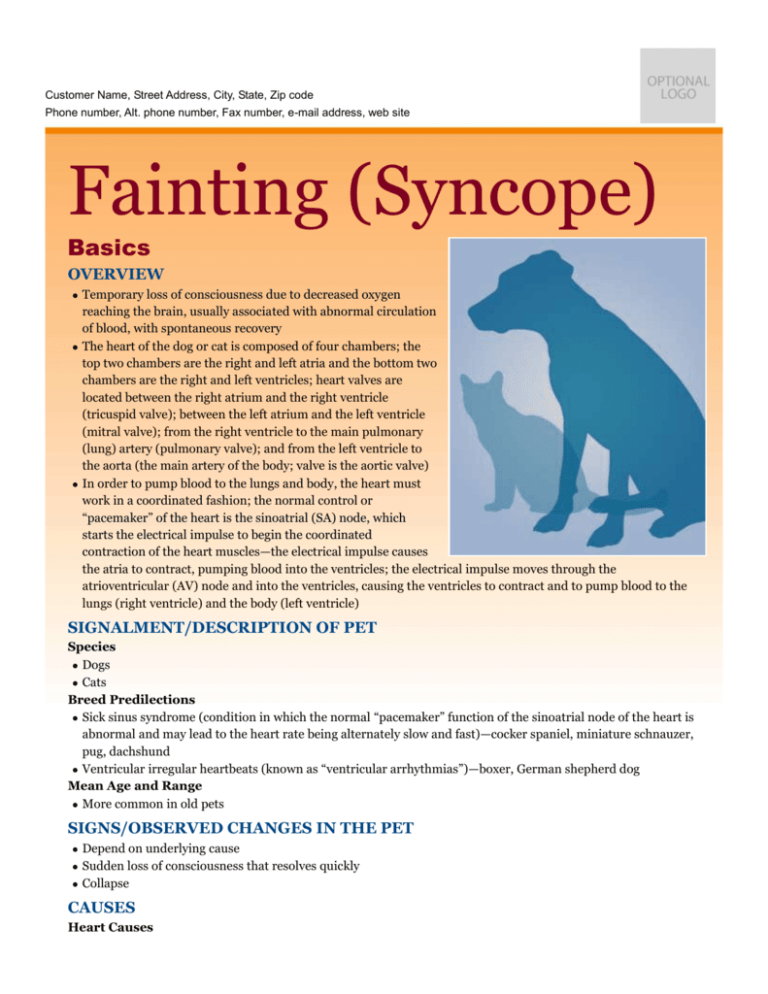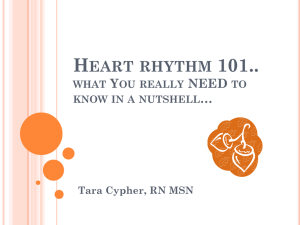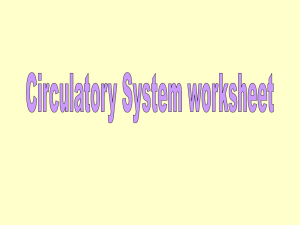fainting_(syncope)
advertisement

Customer Name, Street Address, City, State, Zip code Phone number, Alt. phone number, Fax number, e-mail address, web site Fainting (Syncope) Basics OVERVIEW Temporary loss of consciousness due to decreased oxygen reaching the brain, usually associated with abnormal circulation of blood, with spontaneous recovery The heart of the dog or cat is composed of four chambers; the top two chambers are the right and left atria and the bottom two chambers are the right and left ventricles; heart valves are located between the right atrium and the right ventricle (tricuspid valve); between the left atrium and the left ventricle (mitral valve); from the right ventricle to the main pulmonary (lung) artery (pulmonary valve); and from the left ventricle to the aorta (the main artery of the body; valve is the aortic valve) In order to pump blood to the lungs and body, the heart must work in a coordinated fashion; the normal control or “pacemaker” of the heart is the sinoatrial (SA) node, which starts the electrical impulse to begin the coordinated contraction of the heart muscles—the electrical impulse causes the atria to contract, pumping blood into the ventricles; the electrical impulse moves through the atrioventricular (AV) node and into the ventricles, causing the ventricles to contract and to pump blood to the lungs (right ventricle) and the body (left ventricle) SIGNALMENT/DESCRIPTION OF PET Species Dogs Cats Breed Predilections Sick sinus syndrome (condition in which the normal “pacemaker” function of the sinoatrial node of the heart is abnormal and may lead to the heart rate being alternately slow and fast)—cocker spaniel, miniature schnauzer, pug, dachshund Ventricular irregular heartbeats (known as “ventricular arrhythmias”)—boxer, German shepherd dog Mean Age and Range More common in old pets SIGNS/OBSERVED CHANGES IN THE PET Depend on underlying cause Sudden loss of consciousness that resolves quickly Collapse CAUSES Heart Causes Slow heart rate (known as “bradycardia” or “bradyarrhythmia”)—types include sinus bradycardia, sinus arrest, second-degree heart or atrioventricular block, complete heart or AV block, atrial standstill Rapid heart rate (known as “tachycardia” or “tachyarrhythmia”)—types include ventricular tachycardia, supraventricular tachycardia, atrial fibrillation Low blood volume being pumped by the heart (known as “low cardiac output”) not related to irregular heartbeats (arrhythmias)—disease of heart muscle (known as “cardiomyopathy”); long-term (chronic) mitral valve disease; birth defect involving narrowing just below the aortic valve, the heart valve from the left ventricle to the aorta (the main artery of the body; condition known as “subaortic stenosis”); birth defect involving narrowing of the valve from the right ventricle to the main pulmonary (lung) artery (pulmonary valve; condition known as “pulmonic stenosis”); heartworm disease; blood clots to the lungs (known as “pulmonary embolism”); heart tumor Nervous System and Blood Vessel Responses “Vasovagal syncope”—emotional stress and excitement may cause heightened sympathetic nervous system stimulation, leading to transient rapid heart rate (tachycardia) and high blood pressure (known as “hypertension”), which is followed by a compensatory response of the vagus nerve, leading to excessive enlargement or dilation of blood vessels, without a compensatory rise in heart rate and blood flow; a slow heart rate (bradycardia) often occurs “Situational syncope” refers to fainting (syncope) associated with coughing, defecation, urination, and swallowing “Carotid sinus hyperactivity” may cause low blood pressure (known as “hypotension”) and slow heart rate (bradycardia)—often the cause of fainting (syncope) when one pulls on a dog’s collar; the carotid sinus in located in the carotid artery—it acts in the regulation of blood pressure Miscellaneous Causes Drugs that affect blood pressure and regulation of the autonomic nervous system; the autonomic nervous system is involved in the control of muscles in the heart, blood vessels, gastrointestinal tract, and other organs; it is composed of two parts—the sympathetic and the parasympathetic parts; the two parts cause opposing responses; for example, the sympathetic nervous system speeds up the heart and causes the blood vessels to constrict or become small while the parasympathetic nervous system slows the heart and causes the blood vessels to expand or dilate Low blood sugar (known as “hypoglycemia”); low levels of calcium in the blood (known as “hypocalcemia”); and low levels of sodium in the blood (known as “hyponatremia”) Increased levels of red blood cells or proteins in the blood leading to sludging of the blood [known as “hyperviscosity syndromes”] and impaired blood flow to the brain (rare) RISK FACTORS Heart disease Sick sinus syndrome (condition in which the normal “pacemaker” function of the heart is abnormal and may lead to the heart rate being alternately slow and fast) Drug therapy—medications to enlarge or dilate blood vessels (known as “vasodilators,” such as calcium channel blockers, angiotensin converting enzyme [ACE] inhibitors, hydralazine, and nitrates), phenothiazine tranquilizers (such as acepromazine), medications to control irregular heartbeats (known as “antiarrhythmics”), and medications to remove excess fluid from the body (known as “diuretics”) Treatment HEALTH CARE Avoid or discontinue medications likely to precipitate fainting (syncope); medication should be changed only as directed by your pet’s veterinarian Treat as outpatient, unless important heart disease is evident ACTIVITY Low blood volume being pumped by the heart (known as “low cardiac output”)—minimize activity SURGERY Pacemaker implantation for some cases, such as pets with sick sinus syndrome (condition in which the normal “pacemaker” function of the heart is abnormal and may lead to the heart rate being alternately slow and fast) and advanced heart blocks Medications Medications presented in this section are intended to provide general information about possible treatment. The treatment for a particular condition may evolve as medical advances are made; therefore, the medications should not be considered as all inclusive SLOW HEART RATE (BRADYCARDIA OR BRADYARRHYTHMIA) Correct metabolic causes Medications used to increase the heart rate (known as “anticholinergics”), such as atropine, propantheline bromide, hyocyamine sulfate Medications used to mimic the effect of the sympathetic nervous system to speed up the heart rate (known as “sympathomimetics”), such as isoproterenol and medications to enlarge or dilate the bronchi and bronchioles (known as “bronchodilators”) Pacemaker implantation in some pets RAPID HEART RATE (TACHYCARDIA OR TACHYARRHYTHMIA) Irregular heart beat caused by problems in the atria (known as “atrial arrhythmias”)—administer digoxin, β– blocker, or diltiazem Irregular heart beat caused by problems in the ventricles (known as “ventricular arrhythmias”)—administer lidocaine, procainamide, mexiletine, sotalol, or β–blocker LOW BLOOD VOLUME BEING PUMPED BY THE HEART (LOW CARDIAC OUTPUT) Institute treatment to improve blood volume being pumped by the heart (cardiac output), which varies according to specific heart disease NERVOUS SYSTEM AND BLOOD VESSEL RESPONSE (VASOVAGAL) Theophylline or aminophylline—sometimes helpful β-blockers (such as atenolol, propranolol, and metoprolol) indirectly may prevent stimulation of the vagus nerve Medications used to increase the heart rate (anticholinergics) may blunt the response of the vagus nerve Follow-Up Care PATIENT MONITORING Serial recordings of an electrocardiogram (ECG, a recording of the electrical activity of the heart) or Holter monitoring (where the pet wears a “vest” in which a continuous, mobile battery-powered ECG monitor has been placed; the ECG recording is performed over several hours, giving a better overall picture of the heart rate and rhythm) to assess effectiveness of medications to control irregular heart beat (antiarrhythmic therapy) PREVENTIONS AND AVOIDANCE Minimize stimuli that precipitate episodes Low blood volume being pumped by the heart (low cardiac output)—minimize activity Vasovagal response—minimize excitement and stress Cough—remove collar POSSIBLE COMPLICATIONS Injury when “collapse” occurs Death EXPECTED COURSE AND PROGNOSIS Most non-heart causes are not life-threatening Heart causes may be treated, but fainting (syncope) in pets with heart disease may suggest higher risk of death Key Points Temporary loss of consciousness due to decreased oxygen reaching the brain, usually associated with abnormal circulation of blood Most non-heart causes are not life-threatening Heart causes may be treated, but fainting (syncope) in pets with heart disease may suggest higher risk of death Enter notes here Blackwell's Five-Minute Veterinary Consult: Canine and Feline, Fifth Edition, Larry P. Tilley and Francis W.K. Smith, Jr. © 2011 John Wiley & Sons, Inc.





